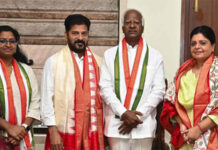There may not be any grand alliance in the near future. Modi has already won the semifinals for the future. The BJP’s dominant show in the Uttar Pradesh assembly polls has put a big question mark over the politics of maha gathbandhan in the run up to the 2019 general elections.
The ‘third front’ alternative – a coalition of big and small parties – have assumed power on two occasions at the Centre and several times in Uttar Pradesh.

As late as 2015, a ‘maha gatbandhan of’ of the JD-U, RJD and Congress had successfully checkmated the saffron party in Bihar.
But the near decimation of the Samajwadi Party-Congress alliance in Uttar Pradesh might have ended prospects of a coming together of oppostion parties in the next Lok Sabha polls.
Old socialists, who had successfully orchestrated “identity politics” in the Hindi heartland states in the last three decades, are either dead or have been diminished by advancing age.

Much hope was reposed in the youthful Samajwadi Party leader Akhilesh Yadav to emerge the poster boy of a reinvented brand of socialist politics.
The SP-Congress alliance of UP was no more than a patchwork as compared to the show of complete unity put up by the RJD-JDU-Congress in adjoining Bihar ahead of the 2015 assembly elections.
Akhilesh spurned offers from Ajit Singh’s Rashtriya Lok Dal (RLD) and Nitish Kumar’s Janata Dal (United) to align with the grouping.

There was no effort to rope in BSP leader Mayawati for a pre-poll alliance. The absence of Sonia and Priyanka Gandhi also took considerable sheen off the “maha gathbandhan” pitch.
“The outcome may have been somewhat different if more effort had been made in stitching together a genuine alliance,” an SP leader said.














